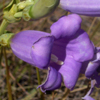SEARCH the
Gentian Research Network
and Rutgers University:
GENTIANS
Classification (newest)
List of genera
List by tribe
Gentian characteristics
Gentianales
RESEARCH
Research projects
People, addresses
Literature, publications
Links
Add info to
this site
TOPICS
Anatomy
Common names
Ecology - Natural history
GEOGRAPHY
Floras
Latin America
North America
TRIBES
Saccifolieae
_____________________
Information in other languages:
_____________________
This page
is maintained
by Dr.
Lena
Struwe
(e-mail),
and hosted by
Rutgers University, USA
updated: 01/19/11
| Calolisianthus (Gentianaceae: Helieae: Calolisianthus) |
 |
||||||||||||
|
Latin
name and synonyms: Calolisianthus (Griseb.) Gilg (1895) Etymology: After kalos (Greek for beautiful) and lisi- (for smooth or even, not ridged or hairy), and -anthus (flower), meaning "beautiful smooth flower". Species: 6 species. This genus is currently being studied by Maria Fernanda Calío (University of São Paulo) for taxonomic, conservation, and biogeographic research questions. Distribution: Neotropics, southeastern Brazil to Bolivia, from 200 m to the mountains of the Brazilian Highlands. Habitat: Savannas, forests, and grasslands, especially campo rupestre in Southeastern Brazil. Characteristics: Unbranched, perennial herbs, sometimes woody at the base. Leaves sessile, often leathery, and oblong-elliptic. Inflorescences terminal, usually few-flowered, with short, monochasial branches (flowers one by one on one side of the branch), with scale-like bracts. Flowers 5-merous, horizontal or nodding, slightly zygomorphic. Calyx campanulate, thick and leathery, persistent in fruit; calyx lobes elliptic with a dorsal glandular ridge. Corolla showy, large, salvershaped to funnelshaped, blue, purple, or red, with rounded or acute lobes. Stamens inserted close to the base inside the corolla tube; filaments sometimes strongly bent close to the anther. Anthers oblong, with a sterile apical appendage. Pollen released as tetrads (most species) or polyads with reticulate exine. Ovary with glandular disk at the base; style long, slender; stigma bilamellate. Capsules elliptic, often nodding. Seeds many, small. Evolution and related plants: Calolisianthus belongs to the Symbolanthus clade in the tribe Helieae. Economic uses: None known. Notes: Calolisianthus has sometimes been included in the genus Irlbachia, but this is not supported by new, evolutionary DNA evidence (Struwe et al., 2002). Accepted species (synonyms in parenthesis) and their distribution:
Gilg, E. 1895. Gentianaceae. Pp. 50-180. In: A. Engler & K. Prantl, editors. Die natürlichen Pflanzenfamilien, vol. 4(2). Verlag von Wilhelm Engelmann, Leipzig. Maas, P. J. M. 1985. Nomenclatural notes on neotropical Lisyantheae (Gentianaceae). Proc. Kon. Ned. Akad. Wetensch., Ser. C, 88: 405-412. Nilsson, S. 1970. Pollen morphological contributions to the taxonomy of Lisianthus L. s. lat. (Gentianaceae). Sv. Bot. Tidskrift 64: 1-43. Struwe, L. & V. A. Albert. 1998a. Lisianthius (Gentianaceae), its probable homonym Lisyanthus, and the priority of Helia over Irlbachia as its substitute. Harvard Pap. Bot. 3: 63-71. Struwe, L., J. W. Kadereit, J. Klackenberg, S. Nilsson, M. Thiv, K. B. von Hagen, & V. A. Albert. 2002. Systematics, character evolution, and biogeography of Gentianaceae, including a new tribal and subtribal classification. Pp. 21-309. In: L. Struwe & V. A. Albert (eds.), Gentianaceae: Systematics and Natural History, Cambridge University Press, Cambridge. Struwe, L., P. J. M. Maas, & V. A. Albert. 1997. Aripuana cullmaniorum, a new genus and species of Gentianaceae from white-sands of southeastern Amazonas, Brazil. Harvard Pap. Bot. 2: 235-253. Struwe, L., P. J. M. Maas, O. Pihlar, & V. A. Albert. 1999. Gentianaceae. Pp. 474-542. In: P. E. Berry, K. Yatskievych, & B. K. Holst, editors. Flora of the Venezuelan Guayana, vol. 5. Missouri Botanical Garden, St. Louis.
© Lena Struwe, 2004 |
|||||||||||||
